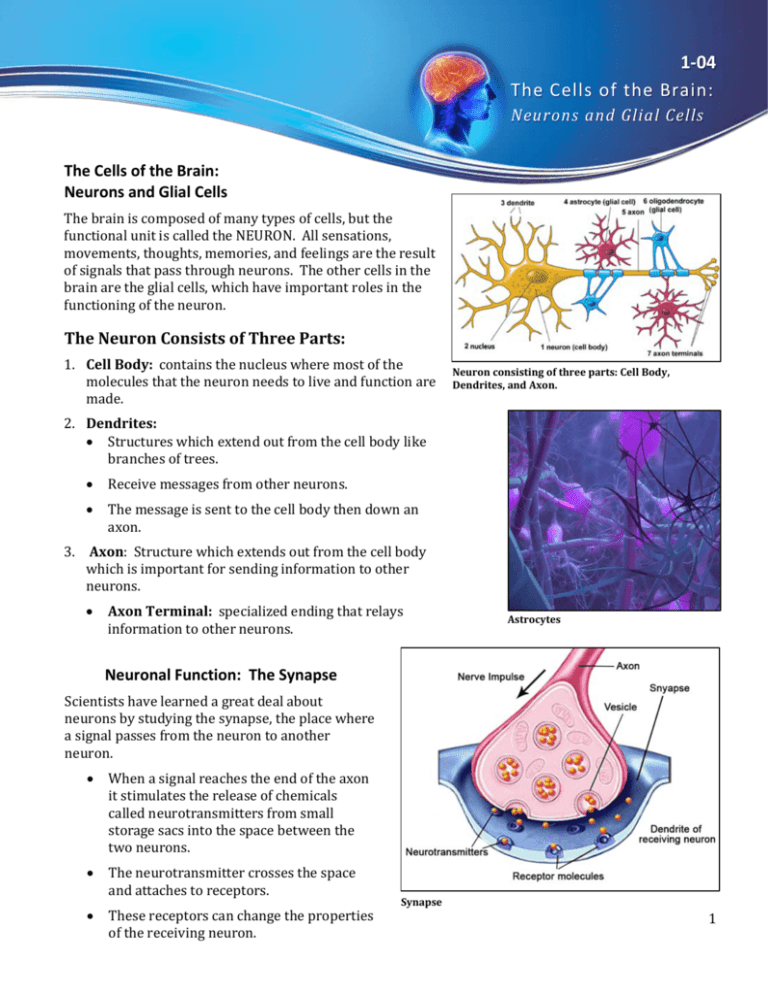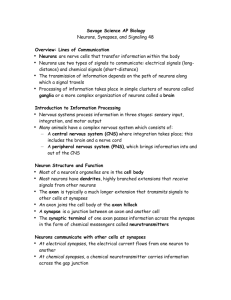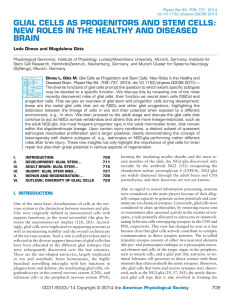1-04 The Cells of the Brain:
advertisement

1-04 The Cells of the Brain: Neurons and Glial Cells The Cells of the Brain: Neurons and Glial Cells The brain is composed of many types of cells, but the functional unit is called the NEURON. All sensations, movements, thoughts, memories, and feelings are the result of signals that pass through neurons. The other cells in the brain are the glial cells, which have important roles in the functioning of the neuron. The Neuron Consists of Three Parts: 1. Cell Body: contains the nucleus where most of the molecules that the neuron needs to live and function are made. Neuron consisting of three parts: Cell Body, Dendrites, and Axon. 2. Dendrites: • Structures which extend out from the cell body like branches of trees. • • Receive messages from other neurons. The message is sent to the cell body then down an axon. 3. Axon: Structure which extends out from the cell body which is important for sending information to other neurons. • Axon Terminal: specialized ending that relays information to other neurons. Astrocytes Neuronal Function: The Synapse Scientists have learned a great deal about neurons by studying the synapse, the place where a signal passes from the neuron to another neuron. • • • When a signal reaches the end of the axon it stimulates the release of chemicals called neurotransmitters from small storage sacs into the space between the two neurons. The neurotransmitter crosses the space and attaches to receptors. These receptors can change the properties of the receiving neuron. Synapse 1 1-04 Examples of Neurotransmitters and Their Role in the Brain Acetylcholine • • GABA • • Acetylcholine generally makes cells more excitable. Alzheimer’s disease, which affects memory formation, is associated with a shortage of acetylcholine. GABA tends to make neurons less excitable. Medications that increase GABA levels in the brain have been used to treat seizures and tremors in patients. Serotonin • • Serotonin is a neurotransmitter that is involved in behavior, mood, appetite, and pain. Medications that cause the brain’s levels of serotonin to increase have been used to treat depression. Dopamine • • Dopamine is involved in mood and the control of muscle movement. The loss of dopamine in some parts of the brain can lead to Parkinson’s disease. Glial Cells Gial cells provide support for the brain, assisting in repair and maintenance, assiting in the development of the nervous system, and providing metabolic functions for neurons. Types of Glial Cells Astrocytes • Astrocytes get their name from their “star” shape. • Astrocytes surround capillaries and form the “blood brain barrier” that restricts what substances can enter the brain. • Astrocytes store nutrients for use by the neurons. Oligodendrocytes • • Oligodendrocytes cover the axons of the neurons providing the “myelin” sheath. The Schwann cell provides this same function in the peripheral neurons. Microglial Cells • • Microglial cells are a specialized white blood cell in the brain. Recognizes foreign substances and destroys them. 2 1-04 Neuronal Malfunction Neuronal Malfunction can occur in the following ways: • • • Loss of Neurons - This occurs in a stroke where part of the brain tissue dies. Loss of Myelin - Multiple Sclerosis is a disease where the myelin around the axon no longer is present due to death of the oligodendrocytes. Loss of Receptors for the Neurotransmitters - Myasthenia gravis is a disease where the receptors for acetylcholine are destroyed rendering a loss of motor function. Prepared by: Grand Valley State University Office of the Vice Provost for Health Veterans Traumatic Brain Injury Education Project Cook-DeVos Center for Health Sciences 301 Michigan St. NE, 500 CHS Grand Rapids, MI 49503-3314 www.gvsu.edu/veteranstbi Authored material: Theresa Bacon-Baguley, PhD, RN References: 1. NIH Publication No.11-3440d, http://www.ninds.nih.gov/disorders/brain_basics/ninds_neuron.htm 2. Veterans TBI Education Project 8/8/2013 3. Cells of the Central Nervous System. Alila Medical Images – www.alilamedicalimages.com Copyright © 2013 Grand Valley State University Version: 8/8/2013 The contents of the “Patient Education Handouts for Veterans and Their Families,” and the DVD collection, such as text, graphics, images, information obtained (collectively, “The Content”) are offered as a courtesy for informational purposes only. The Content is not intended to be a substitute for medical, legal, or other professional advice, diagnosis, or treatment. Grand Valley State University does not guarantee and is not liable for the content or accuracy of the information found in the Patient Education Handouts, DVD, and/or website. 3









